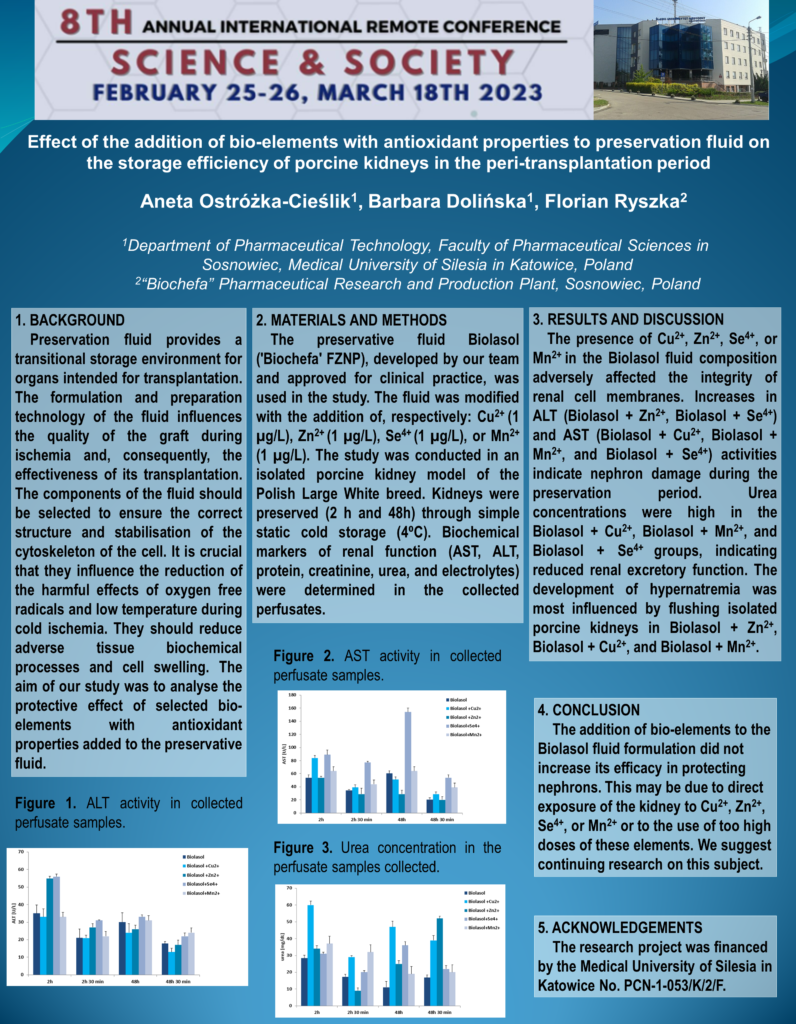Aneta Ostróżka-Cieślik
Conference 2023 Presentation
Project title
Effect of the addition of bio-elements to preservation fluid on the storage efficiency of porcine kidneys in the peri-transplantation period
Authors and Affiliations
Aneta Ostróżka-Cieślik1, Barbara Dolińska1, Florian Ryszka2
1 Department of Pharmaceutical Technology, Faculty of Pharmaceutical Sciences in Sosnowiec, Medical University of Silesia in Katowice, Poland
2 “Biochefa” Pharmaceutical Research and Production Plant, Sosnowiec, Poland
Abstract
Background
Preservation fluid provides a transitional storage environment for organs intended for transplantation. The formulation and preparation technology of the fluid influences the quality of the graft during ischemia and, consequently, the effectiveness of its transplantation. The components of the fluid should be selected to ensure the correct structure and stabilisation of the cytoskeleton of the cell. It is crucial that they influence the reduction of the harmful effects of oxygen free radicals and low temperature during cold ischemia. They should reduce adverse tissue biochemical processes and cell swelling. The aim of our study was to analyse the protective effect of selected bio-elements with antioxidant properties added to the preservative fluid.
Methods
The preservative fluid Biolasol (‘Biochefa’ FZNP), developed by our team and approved for clinical practice, was used in the study. The fluid was modified with the addition of, respectively: Cu2+ (1 µg/L), Zn2+ (1 µg/L), Se4+ (1 µg/L), or Mn2+ (1 µg/L). The study was conducted in an isolated porcine kidney model of the Polish Large White breed. Kidneys were preserved (2 h and 48h) through simple static cold storage (4⁰C). Biochemical markers of renal function (AST, ALT, protein, creatinine, urea, and electrolytes) were determined in the collected perfusates.
Results
The presence of Cu2+, Zn2+, Se4+, or Mn2+ in the Biolasol fluid composition adversely affected the integrity of renal cell membranes. Increases in ALT (Biolasol + Zn2+, Biolasol + Se4+) and AST (Biolasol + Cu2+, Biolasol + Mn2+, and Biolasol + Se4+) activities indicate nephron damage during the preservation period. Urea concentrations were high in the Biolasol + Cu2+, Biolasol + Mn2+, and Biolasol + Se4+ groups, indicating reduced renal excretory function. The development of hypernatremia was most influenced by flushing isolated porcine kidneys in Biolasol + Zn2+, Biolasol + Cu2+, and Biolasol + Mn2+.
Conclusions
The addition of bio-elements to the Biolasol fluid formulation did not increase its efficacy in protecting nephrons. This may be due to direct exposure of the kidney to Cu2+, Zn2+, Se4+, or Mn2+ or to the use of too high doses of these elements. We suggest continuing research on this subject.
The research was financed by the Medical University of Silesia in Katowice: No. PCN-1-053/K/2/F.

